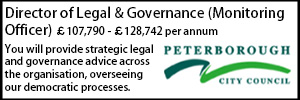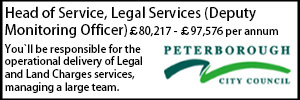Climate legal risk and property: what local authorities need to know
Meena Kamath considers why climate risk is a legal issue for local government and how new clauses drafted by the Chancery Lane Project can help address it.
- Details
Property lawyers have long been accustomed to managing risks such as title defects and funding constraints. Climate risk now sits firmly alongside these, as part of the core legal landscape. Today’s property lawyer must identify, report on, and act upon climate-related issues with the same rigour as any other material risk.
Reports on title and the contracts associated with them are a natural starting point. Working with leading industry experts, legal nonprofit, The Chancery Lane Project (TCLP) has developed two new clauses for use with residential and commercial reports on title. The clauses align with and build on the concepts and wording from Practice Note on Climate Change and Property from The Law Society of England and Wales, providing a practical way to bring climate risk into everyday practice.
Why climate risk is a legal risk
There is a growing consensus, including from The Law Society, that climate risk is now a mainstream legal issue. Its guidance identifies three main categories of risk. Physical risks are the direct impacts of events such as floods, heatwaves, wildfires and droughts, which can damage assets, increase insurance costs or disrupt supply chains. Transition risks stem from the shift to net zero, including costs from new regulations, stakeholder pressure and market changes. Liability and legal risks arise when physical or transition risks are not addressed, leading to litigation, enforcement, negligence claims, or regulatory and contractual consequences such as penalties, redesign requirements and associated cost burdens.
All of these can affect property values, as well as the ability to insure, finance or dispose of property assets. Lawyers are not qualified to advise on physical risk or matters of climate science. They must, however, understand enough to advise competently on legal risk.
For local government, the stakes are high. Many authorities have set ambitious climate targets and some have declared climate emergencies. Acquiring property without factoring in retrofit, resilience, or adaptation costs can undermine those targets, potentially exposing the authority to challenge. In urban regeneration projects, local government entities often act as planning authorities with significant influence. Failing to utilise contracts to embed climate obligations is a missed opportunity that can lock authorities into inefficient assets for decades.
Consider a local council acquiring a neglected building for regeneration. Outdated drainage could leave the property exposed to intense rainfall, while warmer, wetter winters increase the likelihood of damp and mould, raising tenant health concerns and potential landlord liability. Transition risks compound the problem: higher insurance premiums, significant retrofit costs to meet energy standards, and the potential for reputational damage if the asset undermines the council’s net-zero commitments. If long leases or development agreements are then signed without obligations on addressing retrofit or resilience, the authority may be left with inefficient, non-compliant assets that decline in value and credibility.
The role of the legal adviser
Climate risk should now be treated as a foreseeable risk and therefore part of a lawyer’s core risk management role. This is not a new duty, but sits within existing professional obligations of competence, diligence and acting in a client’s best interests.
The lawyer’s role is to highlight climate risk, advise on contractual protections, and recommend further investigation where necessary. For local authorities, this begins at the due diligence or title investigation stage, where climate-related issues should be raised clearly and early. Lawyers should also identify circumstances where surveyors, valuers, or funders may need to undertake further analysis to assess exposure and resilience.
Beyond investigation, legal advisers play a key role in embedding climate goals into contracts, ensuring responsibilities are fairly allocated and adaptable to future regulation. They also guide authorities on governance, disclosure, and the legal aspects of transition planning, while anticipating emerging laws and policies that present both risks and opportunities. In doing so, lawyers help safeguard assets, strengthen compliance, and support long-term sustainability objectives.
Report on title clauses
It is in this context that TCLP has developed its new clauses. They are designed as a practical starting point for lawyers to address climate risks in property transactions by providing a structured framework for reporting.
- Marni’s Clause (Commercial) updates TCLP’s existing report on title wording for commercial property.
- Isabella’s Clause (Residential) applies similar principles to the residential context, recognising that climate risk affects homeowners and tenants as much as investors.
The new clauses are designed to give lawyers clear wording and practical options for addressing climate issues in property transactions. They help solicitors move beyond a narrow, tick-box approach and provide clients with meaningful advice that anticipates future risks.
One area covered is climate searches. These searches, widely available from commercial providers, assess a property’s exposure to climate hazards. Unlike standard flood or environmental searches, which focus only on historical data, climate searches offer future projections. The clauses explain how these searches work so that clients can make an informed decision, outline the solicitor’s role in advising on the results, and provide alternative wording depending on whether a search has been commissioned and what it reveals.
Energy efficiency is another focus. Rather than simply recording an EPC rating, the clauses encourage a more proactive assessment of potential performance improvements and retrofit costs. They also flag the government’s long-standing proposals to tighten minimum energy efficiency standards, which are particularly relevant for local authorities managing large residential portfolios.
Finally, the clauses align closely with The Law Society’s guidance. They build on its sample wording by offering a more detailed framework and creating an audit trail to demonstrate that climate risk was properly considered at the point of acquisition.
By structuring how climate issues are reported, the clauses help local government lawyers demonstrate compliance with evolving professional standards and ensure that property transactions reflect climate commitments.
From reports to contracts
Reports on title are only the starting point. Once risks are identified, they need to be embedded in the contracts that govern how assets are used, built and managed - whether in supply chain agreements (TCLP’s Kori’s Clause), building contracts (TCLP’s Estelle’s Clause), or green leases (Better Buildings Partnership Toolkit). Reporting is step one, but clauses in contracts help authorities move from risk awareness to collaborative action, enabling authorities, partners and occupiers to work together to deliver on climate goals.
What does this mean for local authorities?
For local authorities, adopting these clauses offers clear and practical benefits. Explicitly addressing climate risk reduces the likelihood of future litigation alleging that foreseeable risks were ignored. By identifying potential stranded asset risks, authorities can make better-informed decisions and protect public funds. At the same time, ensuring property transactions support rather than undermine net-zero targets demonstrates accountability to stakeholders and the public. The adoption of these clauses also positions local authorities as market leaders, setting a benchmark that can influence the behaviour of partners, funders and developers.
Local authorities should consider incorporating these clauses into their standard documentation as a first step on their climate contracting journey. This will help ensure that climate risk is consistently addressed across new acquisitions and regeneration projects. As practice evolves, climate reporting is likely to become as routine as other title checks and a core part of legal due diligence. Over time, additional clauses can be introduced into transaction documents, enabling local authorities not only to safeguard their communities and assets but also to advance public policy and play a leadership role on the path to net zero.
Meena Kamath is Head of Built Environment at The Chancery Lane Project.
Lawyer - Property
Trust Solicitor (Employment & Contract Law)
Contracts & Procurement Lawyer
Senior Lawyer - Contracts & Commercial
Locums
Poll







































